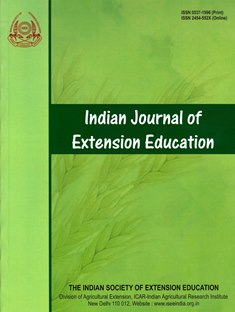Garrett Ranking of Constraints and Satisfaction of Makhana (Euryale ferox) Growers in Bihar
DOI:
https://doi.org/10.48165/IJEE.2025.613RN04Keywords:
Constraints, Garrett ranking, Makhana, Satisfaction, Technological supportAbstract
The study aimed to identify the key constraints Makhana (Euryale ferox) growers face in the districts of Madhubani and Darbhanga, Bihar, and assess their satisfaction with various aspects of Makhana cultivation. The study was conducted in 2024 and 2025, the research involved a total of 360 randomly selected Makhana growers (262 male and 98 female). A descriptive research design was employed, utilizing the Garrett Ranking Method to evaluate constraints and a 5-point Likert scale to assess satisfaction levels across various aspects of cultivation, including production, income, labour, and postharvest practices. The findings revealed that the most significant challenges included skilled labour requirements, land ownership issues, and lack of technological support. Farmers expressed moderate satisfaction with cultivation practices, although satisfaction with income generation was notably low. The study highlights the need for improved technology, better market access, and increased financial support to enhance both productivity and the economic sustainability of Makhana farming. Addressing these constraints could improve farmer satisfaction and ensure the long-term viability of Makhana cultivation in the region.
Downloads
References
Here are the references, separated as requested:
Journal Articles:
Ahmad, A. (2020). A study on constraints of Makhana cultivation and suitable measures for its better development. Journal of Pharmacognosy and Phytochemistry, 9(1), 984–987. https://doi.org/10.22271/PHYTO.2020.V9.I1Q.10580
Das, L., Nain, M. S., Singh, R., & Burman, R. R. (2014). Constraints in marketing of fruits as perceived by the fruit growers and NERAMAC in Assam. Journal of Community Mobilization and Sustainable Development, 9(2), 114–117.
Gireesh, S., Kumbhare, N. V., Nain, M. S., Kumar, P., & Gurung, B. (2019). Yield gap and constraints in production of major pulses in Madhya Pradesh and Maharashtra. Indian Journal of Agricultural Research, 53(1), 104–107.
Kademani, S., Nain, M. S., Singh, R., Kumar, S., Parsad, R., Sharma, D. K., Roy, S. K., Krishna, D. K., Prabhakar, I., Mahapatra, A., & Patil, M. (2024). Unveiling challenges and strategizing solutions for sustainable agri-entrepreneurship development. Frontiers in Sustainable Food Systems, 8, 1447371.
Khadatkar, A., Mehta, C., & Gite, L. (2020). Makhana (Euryale ferox Salisb.): A high-valued aquatic food crop with emphasis on its agronomic management – A review. Scientia Horticulturae, 261, 108995. https://doi.org/10.1016/j.scienta.2019.108995
Kumar, A., Singh, A., Kumar, A., & Kumari, S. (2020). Constraints faced by Makhana growers of Madhubani district and suggestions to eliminate them. Indian Journal of Extension Education, 56(3), 177–180. https://doi.org/10.5958/2454-552X.2020.00032.8
Kumar, A., Singh, A., Kumar, B., & Kumari, S. (2021). A study of knowledge and traditional wisdom of Makhana cultivation in Bihar. Indian Journal of Traditional Knowledge, 20(2), 532–536. https://doi.org/10.56042/ijtk.v20i2.31981
Kumar, S., & Jha, K. (2025). Knowledge gap and path analysis of adopting Makhana (Euryale ferox Salisb) growers in Bihar. Indian Journal of Extension Education. https://doi.org/10.48165/ijee.2025.61115
Kumar, S., & Jha, K. (2025). Understanding entrepreneurial behaviour of Makhana growers in Bihar using SEM-PLS approach. Indian Journal of Extension Education, 61(2), 62–66. https://doi.org/10.48165/IJEE.2025.61212
Kumar, U., Kumar, A., & Singh, K. M. (2011). Constraints and drudgery in Makhana cultivation. International Journal of Extension Education, 7, 47–51. https://doi.org/10.2139/ssrn.2061652
Pathania, A., & Meena, S. S. (2025). Constraints faced by rural youth for opting entrepreneurship as career: A case study of Haryana. Indian Journal of Extension Education, 61(1), 99–103. https://doi.org/10.48165/IJEE.2025.611RN01
Sabu, P. J., & Roy, D. (2024). Constraints faced by paddy farmers in Kerala: An empirical analysis in Palakkad. Indian Journal of Extension Education, 60(4), 99–103. https://doi.org/10.48165/IJEE.2024.604RN3
Sharma, A., Mishra, R., Saw, B., & Ahmad, N. (2020). Economic analysis of Makhana cultivation in Darbhanga and Madhubani districts of Bihar, India. International Journal of Current Microbiology and Applied Sciences, 9, 1097–1102. https://doi.org/10.20546/ijcmas.2020.904.130
Shashi, S., Vasantha, R., Babu, K. M., & Chary, D. S. (2023). Profile characteristics of cultivators of two major Makhana ecosystems in Katihar District of Bihar State. International Journal of Statistics and Applied Mathematics, SP-8(6), 104–109. https://doi.org/10.22271/maths.2023.v8.i6Sb.1366
Singh, H., Singh, P., Singh, R., Kumar, A., & Kumar, A. (2023). Performance of Makhana (Euryale ferox Salisb.) as a highly profitable venture in waterlogged areas prone to flooding. International Journal of Statistics and Applied Mathematics. https://doi.org/10.22271/maths.2023.v8.i4si.1133
Singh, I., Kumar, M., Raut, S., Thakur, A., & Singh, S. (2020). Integrated nutrient management package for field cultivation of Makhana in North Bihar. Journal of Animal Science, 7, 138–141. https://doi.org/10.21921/jas.v7i03.18687
Valaei, N., Rezaei, S., & Emami, M. (2017). Explorative learning strategy and its impact on creativity and innovation. Business Process Management Journal, 23(5), 957–983. https://doi.org/10.1108/bpmj-12-2015-0179
Downloads
Published
Issue
Section
License

This work is licensed under a Creative Commons Attribution-NonCommercial-NoDerivatives 4.0 International License.

